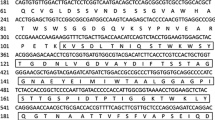Abstract
The cell surface display technique allows expression of target proteins or peptides on microbial cell surface by fusing an appropriate protein as an anchoring motif. Herein, we constructed an Escherichia coli-based whole-cell biocatalyst displaying Thermomyces lanuginosus DSM 5826 xylanase (XynA) on the cell surface and endowed the E. coli cells with the ability to degrade xylan. The XynA was fused in frame to the C-terminus of Lpp-OmpA fusion previously shown to direct various other heterologous proteins to E. coli cell surface. The expressed Lpp-OmpA-XynA fusion protein has a molecular weight of approximately 37 kDa, which was confirmed by SDS-PAGE and Western blot analysis. The enzyme activity of the surface-displayed xylanase showed clear halo around the colony. The XynA-displaying E. coli-based whole-cell biocatalyst xylanase activity was mainly detected with whole cells by determination of activity. The XynA-displaying E. coli-based whole-cell biocatalyst showed highest XynA activity at pH 6.2 and 65 °C, respectively. These results suggest that E. coli, which displayed the xylanase on its surface, could be used as a whole-cell biocatalyst in xylooligosaccharide production.





Similar content being viewed by others
References
Beg QK, Kapoor M, Mahajan L, Hoondal GS (2001) Microbial xylanases and their industrial applications. Appl Microbiol Biotechnol 56:326–338
Chapla D, Pandit P, Shah A (2012) Production of xylooligosaccharides from corncob xylan by fungal xylanase and their utilization by probiotics. Bioresour Technol 115:215–221
Chu YF, Hsu CH, Soma PK, Lo YM (2009) Immobilization of bioluminescent E. coli cells using natural and artificial fibers treated with polyethyleneimine. Bioresour Technol 100:3167–3174
Collins T, Gerday C, Feller G (2005) Xylanases, xylanase families and extremophilic xylanases. FEMS Microbiol Rve 29:3–23
Coughlan MP, Hazlewood GP (1993) β-1,4-d-xylan degrading enzyme systems: biochemistry, molecular biology and applications. Biotechnol Appl Biochem 17:259–289
Daugherty PS, Chen G, Olson MJ, Iverson BL, Georgiou G (1998) Antibody affinity maturation using bacterial surface display. Protein Eng 11:825–832
Francisco JA, Earhart CF, Georgiou G (1992) Transport and anchoring of beta-lactamase to the external surface of Escherichia coli. Proc Nat Acad Sci 89:2713–2717
Francisco JA, Georgiou G (1994) The expression of recombinant proteins on the external surface of Escherichia coli. Ann NY Acad Sci 745:372–382
George G, Daren LS, Stathopoulos C, Heather LP, John M, Charles FE (1996) Display of β-lactamase on the Escherichia coli surface: outer membrane phenotypes conferred by Lpp-OmpA-lactamase fusions. Protein Eng 9(2):239–247
Georgiou G, Stathopoulos C, Daugherty PS, Nayak AR, Iverson BL, Curtiss R (1997) Display of heterologous proteins in the surface of microorganisms: from the screening of combinatorial libraries to live recombinant vaccines. Nat Biotechnol 15:29–34
Gomes J, Gomes I, Kreiner W, Esterbauer H, Sinner M, Steiner W (1993) Production of high level xylanase by a wild strain of Thermomyces lanuginosus using beechwood xylan. J Biotechnol 30:283–297
Jo JH, Im EM, Kim SH, Lee HH (2011) Surface display of human lactoferrin using a glycosyl phosphatidylinositol-anchored protein of Saccharomyces cerevisiae in Pichia pastoris. Biotechnol Lett 33:1113–1120
Jo JH, Han CW, Kim SH, Kwon HJ, Lee HH (2014) Surface display expression of Bacillus licheniformis lipase in Escherichia coli using Lpp-OmpA chimera. J Microbiol 52(10):856–862
Karami A, Latifi AM, Khodi S (2014) Comparison of the organophosphorus hydrolase surface display using InaVN and Lpp-OmpA systems in Escherichia coli. J Microbiol Biotechnol 24(3):379–385
Khandeparker R, Numan MT (2008) Bifunctional xylanases and their potential use in biotechnology. J Microbiol Biotechnol 35:635–644
Kumar S, Nussinov R (2001) How do thermophilic proteins deal with heat? Cell Mol Life Sci 58:1216–1233
Lee SY, Choi JH, Xu Z (2003) Microbial cell-surface display. Trends Biotechnol Amsterdam 21:45–52
Li M (2000) Applications of display technology in protein analysis. Nat Biotechnol 18:1251–1256
Liu W, Zhao H, Jia B, Xu L, Yan Y (2010) Surface display of active lipase in Saccharomyces cerevisiae using Cwp2 as an anchor protein. Biotechnol Lett 32:255–260
Noureddini H, Gao X, Philkana RS (2005) Immobilized Pseudomonas cepacia lipase for biodiesel fuel production from soybean oil. Bioresour Technol 96:769–777
Polizeli M, Rizzatti A, Monti R, Terenzi H, Jorge J, Amorim D (2005) Xylanases from fungi: properties and industrial applications. Appl Microbiol Biotechnol 67:577–591
Pugsley AP, Kornacker MG (1991) Secretion of the cell surface lipoprotein pullulanase in Escherichia coli. Cooperation or competition between the specific secretion pathway and the lipoprotein sorting pathway. J Biol Chem 26:13640–13645
Sambrook J, Ressell DW (2001) Molecular cloning: a laboratory manual, 3rd edn. Cold Spring Harbor Laboratory Press, Cold Spring Harbor, New York
Schreuder MP, Deen C, Boersma WJ, Pouwels PH, Klis FM (1991) Yeast expressing hepatitis B virus surface antigen determinants on its surface: implications for a possible oral vaccine. Vaccine 14:383–388
Stathopoulos C, Georgiou G, Earhart CF (1992) Characterization of Escherichia coli expressing an Lpp-OmpA(46–159)-PhoA fusion protein localized in the outer membrane. Appl Microbiol Biotechnol 45:12–119
Subramaniyan S, Perma P (2002) Biotechnology of microbial xylanases: enzymology, molecular biology, and application. Crit Rev Biotechnol 22:33–64
Su GD, Zhang X, Lin Y (2010) Surface display of active lipase in Pichia pastoris using Sed1 as an anchor protein. Biotechnol Lett 32:1131–1136
Tatjana C, Vladimir M (1996) Purification and properties of the xylanase produced by Thermomyces lanuginosus. Enzyme Microb Technol 19:289–296
Wei Q, Weilan S (2011) Cloning, expression and characterization of glycoside hydrolase family 11 endoxylanase from Bacillus pumilus ARA. Biotechnol Lett 33:1407–1416
Weill CE, Hanke P (1962) Thin-layer chromatography of malto-oligosaccharides. Anal Chem 34:1736–1737
Wittrup KD (2001) Protein engineering by cell-surface display. Curr Opin Biotechnol 12:395–399
Wu HW, Pei JJ, Jiang Y, Song X, Shao WL (2010) pHsh vectors, a novel expression system of Escherichia coli for the largescale production of recombinant enzymes. Biotechnol Lett 32:795–801
Acknowledgments
This research was supported by the Project of Science and Technology Development Program of Yantai (No. 2014ZH118).
Author information
Authors and Affiliations
Corresponding author
Rights and permissions
About this article
Cite this article
Qu, W., Xue, Y. & Ding, Q. Display of Fungi Xylanase on Escherichia coli Cell Surface and Use of the Enzyme in Xylan Biodegradation. Curr Microbiol 70, 779–785 (2015). https://doi.org/10.1007/s00284-015-0781-2
Received:
Accepted:
Published:
Issue Date:
DOI: https://doi.org/10.1007/s00284-015-0781-2




